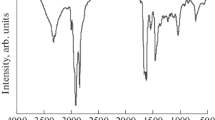Abstract
Partial epoxidation of methyl linoleate was carried out at room temperature (30 °C) using a methyltrioxorhenium catalyst in the presence of pyridine and urea-hydrogen peroxide. Full epoxidation of methyl linoleate was carried out using the Prilezhaev method. The reactions were monitored using the oxirane oxygen content value. The products from partial and full epoxidation were analyzed using GC-FID, FTIR, NMR and GC–MS. Methyl 9,10-epoxy-12Z-octadecenoate and methyl 12,13-epoxy-9Z-octadecenoate were obtained as the major products from partial epoxidation, with a percent yield of 46 %. The product from full epoxidation afforded 97 % yield with methyl 9,10-12,13-diepoxyoctadecanoate as the major component. Physicochemical properties such as kinematic viscosity, viscosity index, crystallization temperature and oxidative stability were examined. Fully epoxidized methyl linoleate exhibits superior kinematic viscosity and oxidative stability due to the complete conversion of double bonds to epoxy groups. Partially epoxidized methyl linoleate exhibits intermediate kinematic viscosity, viscosity index, crystallization temperature and oxidative stability.






Similar content being viewed by others
References
Erhan SZ, Asadauskas S (2000) Lubricant basestocks from vegetable oils. Ind Crops Prod 11:277–282
Adhvaryu A, Erhan SZ, Perez JM (2003) Wax appearance temperatures of vegetable oils determined by differential scanning calorimetry: effect of triacylglycerol structure and its modification. Thermochim Acta 395:191–200
Fox NJ, Stachowiak GW (2007) Vegetable oil-based lubricants—a review of oxidation. Tribol Int 40:1035–1046
Hwang HS, Erhan SZ (2001) Modification of epoxidized soybean oil for lubricant formulations with improved oxidative stability and low pour point. J Am Oil Chem Soc 78:1179–1184
Adhvaryu A, Erhan SZ (2002) Epoxidized soybean oil as a potential source of high-temperature lubricants. Ind Crops Prod 15:247–254
Klaas MR, Warwel S (1999) Complete and partial epoxidation of plant oils by lipase-catalyzed perhydrolysis. Ind Crops Prod 9:125–132
Gan LH, Ooi KS, Goh SH, Gan LM, Leong YC (1995) Epoxidized esters of palm olein as plasticizers for poly(vinyl chloride). Eur Polym J 31:719–724
Doll KM, Erhan SZ (2006) Synthesis and performance of surfactants based on epoxidized methyl oleate and glycerol. J Surfactants Deterg 9:377–383
Salimon J, Salih N, Yousif E (2011) Chemically modified biolubricant basestocks from epoxidized oleic acid: improved low temperature properties and oxidative stability. J Saudi Chem Soc 15:195–201
Goud VV, Patwardhan AV, Dinda S, Pradhan NC (2007) Kinetics of epoxidation of jatropha oil with peroxyacetic and peroxyformic acid catalysed by acidic ion exchange resin. Chem Eng Sci 62:4065–4076
Piazza GJ, Nuñez A, Foglia TA (2003) Epoxidation of fatty acids, fatty methyl esters, and alkenes by immobilized oat seed peroxygenase. J Mol Catal B Enzym 21:143–151
Sun S, Yang G, Bi Y, Liang H (2011) Enzymatic epoxidation of corn oil by perstearic acid. J Am Oil Chem Soc 88:1567–1571
Arends IWCE, Sheldon RA (2002) Recent developments in selective catalytic epoxidations with H2O2. Top Catal 19:133–141
Du G, Tekin A, Hammond EG, Woo LK (2004) Catalytic epoxidation of methyl linoleate. J Am Oil Chem Soc 81:477–480
Kühn FE, Scherbaum A, Herrmann WA (2004) Methyltrioxorhenium and its applications in olefin oxidation, metathesis and aldehyde olefination. J Organomet Chem 689:4149–4164
Gerbase AE, Gregório JR, Martinelli M, Brasil MC, Mendes NF (2002) Epoxidation of soybean oil by methyltrioxorhenium–CH2Cl2/H2O2 catalytic biphasic system. J Am Oil Chem Soc 79:179–181
Wang W, Espenson JH (1998) Effects of pyridine and its derivatives on the equilibria and kinetics pertaining to epoxidation reactions catalyzed by methyltrioxorhenium. J Am Chem Soc 120:11335–11341
Adolfsson H, Converso A, Sharpless KB (1999) Comparison of amine additives most effective in the new methyltrioxorhenium-catalyzed epoxidation process. Tetrahedron Lett 40:3991–3994
Wanasundara UN, Shahidi F (1999) Concentration of omega 3-polyunsaturated fatty acids of seal blubber oil by urea complexation: optimization of reaction conditions. Food Chem 65:41–49
American Oil Chemists’ Society (1998) Official Methods Cd 9-57. Official methods and recommended practices of the American Oil Chemists’ Society, 5th edn AOCS Press, Champaign
Petrovic ZS, Zlatanic A, Lava CC, Sinadinovic-Fiser S (2002) Epoxidation of soybean oil in toluene with peroxyacetic and peroxyformic acids- kinetics and side reactions. Eur J Lipid Sci Technol 104:293–299
American Society for Testing Materials (2006) D 2270—04. Standard practice for calculating viscosity index from kinematic viscosity at 40 and 100 °C. ASTM International, West Conshohocken, PA
Owens GS, Abu-Omar MM (2000) Methyltrioxorhenium-catalyzed epoxidations in ionic liquids. Chem Commun 13:1165–1166
Padley FB, Gunstone FD, Harwood JR (1994) Occurrence and characteristics of oils and fats. In: Gunstone FD, Harwood JL, Padley FB (eds) The lipid handbook, 2nd edn. Chapman and Hall, London, p 50
Socrates G (2001) Infrared and Raman characteristic group frequencies: tables and charts, 3rd edn. Wiley, Chichester
Orellana-Coca C, Adlercreutz D, Andersson MM, Mattiasson B, Hatti-Kaul R (2005) Analysis of fatty acid epoxidation by high performance liquid chromatography coupled with evaporative light scattering detection and mass spectrometry. Chem Phys Lipids 135:189–199
Rodrigues JDA, Cardoso FDP, Lachter ER, Estevão LRM, Lima E, Nascrimento RSV (2006) Correlating chemical structure and physical properties of vegetable oil esters. J Am Oil Chem Soc 83:353–357
Acknowledgments
We would like to thank Universiti Kebangsaan Malaysia for financial support via research grants UKM-AP-2011-017 and DPP-2013-054 and the supporting staff of the School of Chemical Sciences and Food Technology, who contributed greatly to our research.
Author information
Authors and Affiliations
Corresponding author
About this article
Cite this article
Lye, Y.N., Salimon, J. Synthesis and Physicochemical Properties of Partially and Fully Epoxidized Methyl Linoleate Derived from Jatropha curcas Oil. J Am Oil Chem Soc 92, 257–266 (2015). https://doi.org/10.1007/s11746-014-2584-1
Received:
Revised:
Accepted:
Published:
Issue Date:
DOI: https://doi.org/10.1007/s11746-014-2584-1




